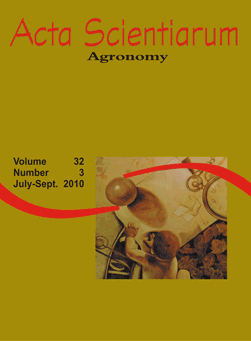<b>Interaction of lime and zinc levels in the morphologic characteristics and production components of castor bean plants</b> - doi: 10.4025/actasciagron.v32i3.5820
Keywords:
Ricinus communis L., castor bean, acidity corrective, micronutrient
Abstract
The objective in this work was to evaluate the effects of lime and zinc levels, as well as their interaction on development in castor bean plants. The hypothesis of this work is that the lime levels reduce the zinc availability in soil for the plant. The experiment was carried out under greenhouse conditions without temperature control, in pots with 17 dm3 of ‘dystrophic Red Latosol’, medium texture. The statistical design was of randomized blocks, in a 3 x 5 factorial scheme, with four replicates. The treatments consisted of liming to reach three basis saturations: 40, 60 and 80%, combined with five zinc levels: 0.5, 1.0, 2.0, 4.0 and 8.0 mg dm-3. Only one plant per pot was grown up to 174 days after emergence (first mature raceme), at which point the morphologic and production components of plants were evaluated. Higher lime levels resulted in greater number of seeds per plant and dry matter of seeds per plant. There was interaction of basis saturation and zinc in plant height, in dry matter of root and in length of raceme (masculine part and total). However, none of these increases reflected a significant difference in weight of 100 castor bean seeds.Downloads
Download data is not yet available.
Published
2010-08-25
How to Cite
Léles, E. P., Fernandes, D. M., Silva, J. I. C. da, & Fumes, L. A. A. (2010). <b>Interaction of lime and zinc levels in the morphologic characteristics and production components of castor bean plants</b> - doi: 10.4025/actasciagron.v32i3.5820. Acta Scientiarum. Agronomy, 32(3), 501-509. https://doi.org/10.4025/actasciagron.v32i3.5820
Issue
Section
Crop Production
DECLARATION OF ORIGINALITY AND COPYRIGHTS
I Declare that current article is original and has not been submitted for publication, in part or in whole, to any other national or international journal.
The copyrights belong exclusively to the authors. Published content is licensed under Creative Commons Attribution 4.0 (CC BY 4.0) guidelines, which allows sharing (copy and distribution of the material in any medium or format) and adaptation (remix, transform, and build upon the material) for any purpose, even commercially, under the terms of attribution.
2.0
2019CiteScore
60th percentile
Powered by 

2.0
2019CiteScore
60th percentile
Powered by 



















































